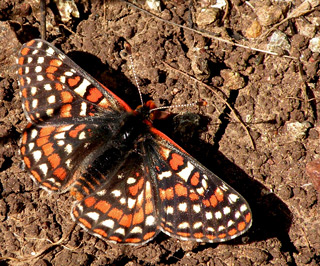Reintroducing of the threatened Bay checkerspot butterfly to Edgewood Park, Northern California
Community and Forum → Blog → Reintroducing of the threatened Bay checkerspot butterfly to Edgewood Park, Northern California
Lev Bely, 08.02.2012 23:19

To meet the declining Californian butterfly Euphydryas editha bayensis, or rather its pupa, you should put yourself to Edgewood Park natural preserve in Northern California, turn your back to the sun and peer at the ground under your shadow. “It takes some practice, but when you see a little black object that stays black, that’s usually a checkerspot,” Dr. Weiss says, a conservation biologist from the Creekside Center for Earth Observation.
To bring the declining butterfly back to the park, last winter Dr. Weiss together with his colleagues “planted” there about 4000 caterpillars. Next few weeks he and volunteers that he calls “checker spotters” will be attentively looking into their shadows to find pupae of last year “seeds”. At the end of March thousands of bright orange-black spotted butterflies should emerge from those pupae.
At first sight this doing might seem rather boring and even meaningless, especially if one knows that checkerspot imagoes live just 10 days; still it's not that trivial. “The checkerspot has become the poster child for the effect of nitrogen on the environment,” Weiss elaborates. Other scientists also agree that for California's biodiversity it could be even more harmful than global warming.
Vehicle from nearby Interstate 280 lavishly “supplies” surroundings exhaust which contains nitrogen oxides that thrown on these lands up to 15 pounds per acre each year. The highway which passes along the western border of the park serves more than 100000 autos between San Francisco and San Jose on busy days.
Nitrogen oxides fertilize soil as well as a common fertilizer used for grass lawns. It makes non-native plants grow aggressively faster. “It’s a matter of competitive ability — the nitrogen-rich soil produces a very strong growth response in annual grasses, like Italian ryegrass,” Dr. Weiss said. “They thatch over and smother native plants.”
If native plants can't develop, so species that needs them begin disappear as E. Editha actually does. Weiss also says that nitrogen not only threatens butterflies but also ruins the ecosysteme, influences negatively human health, water and air.
Once there were lots of checkerspot butterflies in Edgewood Park, but in 2002 they vanished. After the program of mowing and weeding of non-native plants was successfully realized, it's made it possible to keep “invaders” under control and let local plants grow normally.
Biologists are looking forward to see 4000 new pupae over February—March. Weather influences a lot: ideal would be to have a wet winter and a cool summer since humid soil encourages the longer life of plants that butterflies and caterpillars do need. The mission will be deemed completed if about 2000 imagoes appear in Edgewood Park at the end of March. During 10 day life-cycle a checkerspot butterfly will find a couple, lay eggs on the native plantain having begun a new life-cycle, and then die.
Early pupae count promises the results will be as good as expected. Albeit Dr. Weiss and his colleagues will work few more “sowing” seasons to completely recover this species in the park.
The New York Times, http://green.blogs.nytimes.com
Photo: Stuart Weiss
All the rest posts on: species decline, DIY, USA, technology, ecology
Comments
New comment
Note: you should have a Insecta.pro account to upload new topics and comments. Please, create an account or log in to add comments.
* Our website is multilingual. Some comments have been translated from other languages.
Random species of the website catalog
News
- 02.03.2025: Moscow Insect Fair: New section on the Insecta.pro Website
- 31.12.2024: If you need to upload a lot of photos to Insecta.pro website
- 10.12.2024: Новое поле в «Поиске энтомологов»
New photos (28.03.2025)
Fresh from the community
- 23:09, M. Niobius: Здравствуйте. Тульская область, окт...
- 12:52, L. Bolshakov: Петр, см. там подробности: https://...
- 12:32, P. Khramov: Лавр, источник скиньте, пожалуйста....
Popular insects
Recommended blog topics
- ICZN Election of Commissioners
- The petition in defense of biological nomenclature
- The insects exhibition in Kotlas
- Butterflies and music: Union Jack, Papillon



























